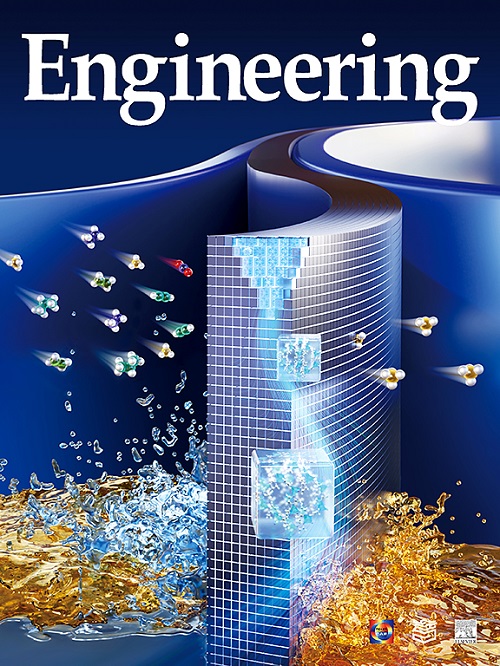A Hybrid Pre-Assessment Assists in System Optimization to Convert Face Masks into Carbon Nanotubes and Hydrogen
IF 10.1
1区 工程技术
Q1 ENGINEERING, MULTIDISCIPLINARY
引用次数: 0
Abstract
With extensive attention being paid to the potential environmental hazards of discarded face masks, catalytic pyrolysis technologies have been proposed to realize the valorization of wastes. However, recent catalyst selection and system design have focused solely on conversion efficiency, ignoring economic cost and potential life-cycle environmental damage. Here, we propose an economic–environmental hybrid pre-assessment method to help identify catalysts and reactors with less environmental impact and high economic returns among various routes to convert discarded face masks into carbon nanotubes (CNTs) and hydrogen. In catalyst selection, it was found that a widely known Fe–Ni catalyst exhibits higher catalytic activity than a cheaper Fe catalyst, potentially increasing the economic viability of the catalytic pyrolysis system by 38%–55%. The use of this catalyst also results in a carbon reduction of 4.12–10.20 kilogram CO2 equivalent for 1 kilogram of discarded face masks, compared with the cheaper Fe catalyst. When the price of CNTs exceeds 1.49 × 104 USD·t–1, microwave-assisted pyrolysis is the optimal choice due to its superior environmental performance (in terms of its life-cycle greenhouse gas reduction potential, eutrophication potential, and human toxicity) and economic benefits. In contrast, conventional heating pyrolysis may be a more economical option due to its good stability over 43 reaction regeneration cycles, as compared with a microwave-assisted pyrolysis catalyst with a higher conversion efficiency. This study connects foundational science with ecological economics to guide emerging technologies in their research stage toward technical efficiency, economic benefits, and environmental sustainability.
混合预评估有助于系统优化转换面罩为碳纳米管和氢
随着废弃口罩潜在的环境危害受到广泛关注,人们提出了催化热解技术来实现废物的增值。然而,最近的催化剂选择和系统设计只关注转化效率,而忽略了经济成本和潜在的生命周期环境破坏。在此,我们提出了一种经济-环境混合预评估方法,以帮助在各种途径中识别环境影响较小、经济回报高的催化剂和反应器,将废弃的面罩转化为碳纳米管(CNTs)和氢气。在催化剂的选择上,我们发现一种广为人知的Fe - ni催化剂比一种更便宜的Fe催化剂表现出更高的催化活性,可能使催化热解系统的经济可行性提高38%-55%。与更便宜的铁催化剂相比,使用这种催化剂还可以减少4.12-10.20千克二氧化碳当量的碳排放。当碳纳米管的价格超过1.49 × 104 USD·t-1时,微波辅助热解因其优异的环境性能(从其生命周期温室气体减排潜力、富营养化潜力和人体毒性方面)和经济效益而成为最佳选择。相比之下,与具有更高转化效率的微波辅助热解催化剂相比,传统加热热解在43个反应再生循环中具有良好的稳定性,因此可能是一种更经济的选择。本研究将基础科学与生态经济学相结合,引导处于研究阶段的新兴技术走向技术效率、经济效益和环境可持续性。
本文章由计算机程序翻译,如有差异,请以英文原文为准。
求助全文
约1分钟内获得全文
求助全文
来源期刊

Engineering
Environmental Science-Environmental Engineering
自引率
1.60%
发文量
335
审稿时长
35 days
期刊介绍:
Engineering, an international open-access journal initiated by the Chinese Academy of Engineering (CAE) in 2015, serves as a distinguished platform for disseminating cutting-edge advancements in engineering R&D, sharing major research outputs, and highlighting key achievements worldwide. The journal's objectives encompass reporting progress in engineering science, fostering discussions on hot topics, addressing areas of interest, challenges, and prospects in engineering development, while considering human and environmental well-being and ethics in engineering. It aims to inspire breakthroughs and innovations with profound economic and social significance, propelling them to advanced international standards and transforming them into a new productive force. Ultimately, this endeavor seeks to bring about positive changes globally, benefit humanity, and shape a new future.
 求助内容:
求助内容: 应助结果提醒方式:
应助结果提醒方式:


